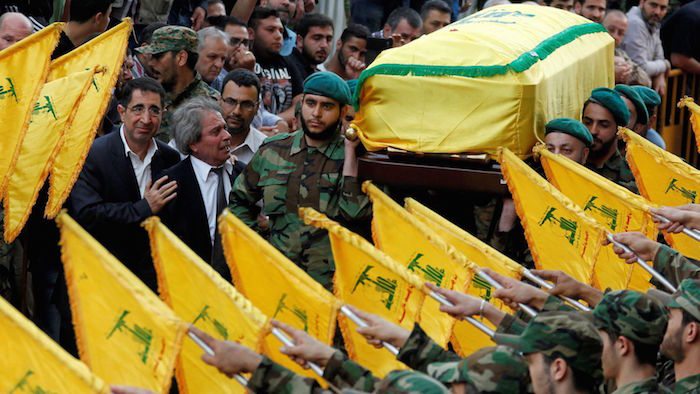Gen. Qasem Soleimani is the commander of the Quds Force, the branch of Iran’s Revolutionary Guards operating abroad. He has a rule: Never draft more than one son from the same family. This is a bitter lesson from the Iran-Iraq War of the 1980s, when dynasties’ whole futures were wiped out.
Now in Syria and Iraq, where Iranian soldiers, officers and advisers are operating, the Iranian command is trying to mute Iranian civilian protest. But it doesn’t always succeed.
Many Iranian volunteers – those in the Basij, the huge volunteer militia numbering more than a million people – get around the order by obtaining Afghani or Pakistani ID documents. They then join brigades like the Afghani Fatemiyoun or the Pakistani Zeinabiyoun, which fight alongside the Syrian regime.
Only when the bodies are returned to Iran does their deeath become known. Some 280 Iranian fighters, including senior officers, have been killed in the fighting since September, a figure that has set off clashes in the Iranian parliament over the Islamic Republic’s involvement in Syria.
Soleimani, who strongly supports Iranian involvement, finds himself facing off against Iranian Foreign Minister Javad Zarif, who isn’t enthusiastic about it. And President Hassan Rohani avoids public pronouncements on the matter.
According to Iranian commentators, recent acrimony over casualty figures was caused by the failed battle for Khan Tuman, south of besieged Aleppo, where more than 50 Iranian fighters were killed including a colonel.
The release of the figures raises another question. In February, U.S. officials and Israeli media reported that all Iranian forces had withdrawn from Syria. Apparently the information isn’t true, or at least is imprecise.
Iran fielded about 2,500 fighters in Syria. Some of them returned home in what Iran defined as “exchanges of forces” but denied there had been a withdrawal.
The latest figures show that there are still hundreds of Iranian fighters in Syria. These will be backed by additional fighters who will tweak their tactics in a bid to reduce casualties.
Russia’s announcement of the withdrawal of its forces also requires scrutiny. Not only are Russian aircraft taking part in battles against the rebels (and not only against the Islamic State, as Russia claimed), Russian “instructors” are fighters taking part on all fronts. Members of the Syrian opposition say Russia and Iran are coordinating closely on security arrangements made when Soleimani visited Moscow on April 14.
According to politician Mohsen Rezaee, chairman of Iran’s Expediency Discernment Council and a former commander of the Revolutionary Guards, Khan Tuman became the nexus of a power struggle between the Syrian army and its partners and the rebels who conquered the town, which is on a road essential for taking Aleppo.
Did the battle for Khan Tuman lead to the killing of Mustafa Badreddine, commander of Hezbollah’s military wing? Rebel social networks have reported that Badreddine, considered the successor to Imad Mughniyeh, was killed on May 6 during the battle for Khan Tuman.
These reports suggest that the Hezbollah version – that Badreddine was killed by a shell or missile fired by Islamist groups when he was at a Hezbollah base near Damascus Airport – is baseless. This is backed up by the rebels’ statements that they have not fired shells or missiles in recent days at the airport, and that the front-line position of one of these groups, Ahrar al-Sham, is 15 kilometers away, while the Islamic State’s is more than 20 kilometers away. Moreover, these groups are not known to have missiles or precise weapons.
If we’re looking for suspects, we should mention that Badreddine was clashing with Hezbollah leaders about tactics against Israel as well as the fielding of Hezbollah forces in Syria. Two years ago, a Kuwaiti newspaper reported that Badreddine had been taken to task over his management of operations of units outside Lebanon. He was accused of being distracted by women, which it was said led to the failure of operations including an attempted terror attack in Thailand.
Mohammed Ataya, the head of Hezbollah’s Unit 113, which is responsible for operations in the West Bank, has been clashing with Badreddine. According to the Kuwaiti paper, Badreddine would go over Ataya’s head to Beirut.
Badreddine’s successor is expected to be Talal Hamiyah, head of operations outside Lebanon, unless it turns out he had something to do with Badreddine’s death.
Hezbollah knows exactly who’s responsible for Badreddine’s death. The organization’s main worry is a possible intelligence breach, especially because Badreddine was known as a stickler for secrecy.
Badreddine’s death will not affect Hezbollah’s role in Syria. The organization’s problem at the moment is not the issue of the top command, but filling its ranks with fighters. It has reportedly lost more than 1,200 men.
Hezbollah will remain loyal to Syrian President Bashar Assad, and as long as there is no political or diplomatic solution in Syria, the war there will keep being defined as an existential need for Hezbollah.

